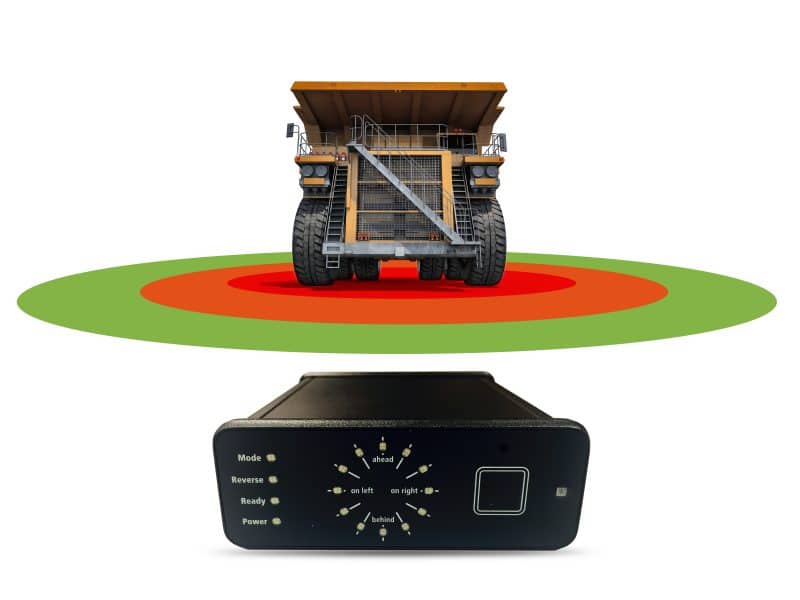The dangers faced by miners every day are too numerous and varied to be addressed by point solutions. Hexagon’s mining division explains how its strengthened MineProtect safety portfolio can help to mitigate these risks.
Hexagon, a global leader in sensor, software and autonomous solutions, has strengthened MineProtect by integrating solutions for collision avoidance and slope stability radar monitoring.
The MineProtect collision avoidance system (CAS) now communicates directly with IBIS Guardian software from sister company IDS GeoRadar, which drastically cuts the time between slope stability risk detection and a workforce’s awareness of it.
Guardian’s integration with CAS means properly equipped office personnel, equipment operators and mine site pedestrians can receive near-real-time equipment visualisation and timely alerts about hazardous areas and no-go zones.
No-go zones are identified in Guardian, which creates geofenced zones and hazard maps, and is correlated with radar alarms.
Guardian’s integration with CAS and complementary MineProtect solutions, personal alert and tracking radar ensures that alarms are automatically triggered when a no-go zone is approached.
The additional layer of information created by the integration means better risk evaluation and is another way to ensure everyone gets home safely.
It also embodies Hexagon’s autonomous connected ecosystems strategy – connecting previously siloed processes in one platform that will help save lives.
Vehicles and machinery are visualised in real time on the 3D radar displacement map and consequently traffic management, based on slope hazards, can be further optimised through real-time monitoring data from IDS GeoRadar’s complementary solutions, Hydra-X, IBIS-FM and IBIS-ArcSAR.
“Others have point-to-point or radio-based processes but can’t really drive the information to the whole fleet,” MineProtect portfolio manager Marcos Bayuelo tells Safe to Work.
“We’ve reduced the time to communicate to the minimum and really ensured that the people that require the information get it as fast as possible.”

The process of alerting a workforce to a slope stability risk can now involve only one person. IDS GeoRadar slope monitoring radars detect movement. The information goes to Guardian, which alerts the geotech crew. The geotech reviews and signs off on the alarms and any no-go zone.
“That person analyses the alarm, and confirms it and the no-go zone,” Bayuelo says.
With a click, and at the speed of the mine’s network, the alarm and no-go zone specifications are distributed through CAS and email.
“The no-go zone is transmitted in near real time,” Bayuelo says.
“Vehicles and vehicle drivers can now be alerted instantly about the incoming hazard. Now they have the capability to visualise where they should not go.
“And if somebody gets in this zone, then the supervisor or mine manager will see that somebody is in the no-go zone.”
Geotechs can set Guardian to monitor certain areas more critically than it does for others.
“You have different levels, and it is up to the mine as to what hazardous area is transformed into a no-go zone,” Bayuelo explains.
“Within Guardian, you say, ‘I want to monitor here, here and here, because this is a slope movement hazard.’ Once that hazard reaches a level of criticality, then the geotechs decide when this becomes a no-go zone because the risk of collapse is so high that nobody should be there.”
IBIS Guardian now assimilates data from the CAS server, automatically importing the position of vehicles and working machineries and visualising them in real time on radar displacement maps.
Highly accurate displacement data is provided to monitoring specialists in near-real time, as it happens, using an advanced automatic atmospheric correction algorithm to avoid mistakes.
“The development should help prompt customers that have one of the two software solutions to upgrade it and to adopt the other,” Bayuelo says.
“Upon adoption, any training required should be minimal and centre on workflow changes.
“The new information that will be presented to them will be intuitive enough for them to understand. There is no huge change management or training regimen required.”
The integration embodies Hexagon’s strategy of autonomously connected ecosystems.
“We are now building solutions that can interact with each other, talk to each other, make decisions with each other and enhance the overall sum of our solutions,” Bayuelo says.
“We don’t only offer the best solutions, but the solutions themselves make the business outcomes better, which is the end goal of our company.”
Technology is only as sound as the people operating it. Change management and a culture of safety are integral to technology’s effectiveness in managing, monitoring and reinforcing a zero-harm approach.
Hexagon’s analytics portfolio, MineEnterprise, is proving to be highly effective in this approach because it provides people with the right data at the right time, allowing them to take action and make improvements.
Hexagon and its customers believe that the most important assets in a mine operation are the people who make mining possible.
To take zero harm seriously, mines need a comprehensive, integrated safety portfolio to mitigate numerous risks, underpinned by an enterprise solution to transform safety data into actionable intelligence and backed by a proven change management methodology to ensure a meaningful safety culture prevails.
This article also appears in the Mar-Apr of Safe to Work.


